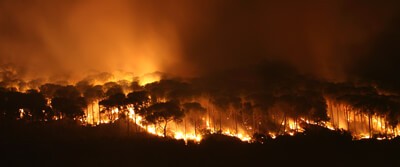Predicting Wildfires with Climate Change Models

By Ralph Birch
Scientists are turning up the heat in the quest to protect populated areas from wildfires.
An international team of researchers employed satellite technology to analyze 23 million wildfires from 2002 through 2013 and identified the locations of nearly 500 of the most extreme wildfires. By pinpointing the most fire-prone areas in eastern Australia and the Mediterranean, researchers are hoping government officials will move to strengthen their defenses and prevent potentially catastrophic consequences of future wildfire events.
Climate change modeling has revealed that the number of days conducive to extreme wildfires could increase up to 50 percent in the years to come.
Learning from the Past
University of Tasmania Professor of Environmental Change Biology David Bowman led a team of researchers — including those from the University of Idaho and South Dakota State University — to identify 478 particularly devastating wildfires. Of those 478, 144 wildfires were found to have occurred in areas where humans have built in highly flammable forest landscapes in southern Australia and western North America.
“Extreme fire events are a global and natural phenomenon, particularly in forested areas that have pronounced dry seasons,” Bowman said. “With the exception of land clearance, the research found that extremely intense fires are associated with anomalous weather — such as droughts, winds, or in desert regions, following particularly wet seasons.”
Forecasting the Future
Future climate change modeling has identified the eastern coast of Australia, including the city of Brisbane, as well as Mediterranean countries like Spain, Portugal, France, Greece and Turkey as prime territory for extreme wildfire events to occur.
“The projections suggest an increase in the days conducive to extreme wildfire events by 20 to 50 percent in these disaster-prone landscapes, with sharper increases in the subtropical Southern Hemisphere, and the European Mediterranean Basin,” Bowman said.
Remembering Black Tuesday
The research conducted by Bowman and his team was published in Nature Ecology and Evolution. Their findings were revealed on the 50th anniversary of the devastating 1967 Hobart bushfires which claimed the lives of 62 Australians, injured 900 and left 7,000 homeless. February 7, 1967 is known as Black Tuesday for the damage left in the wake of 110 separate fires that burned through 652,000 acres of Tasmanian land in just five hours.
A late winter and early, wet spring that year led to an abundance of vegetation in southern Tasmania, but the combination of dry weather, high temperatures and strong winds is what started the legendary string of wildfires.
Discussion Questions
- What are some ways people can help protect wooded areas from fire?
- Aside from the locations listed in the article, what other areas of the world do you think are susceptible to wildfires?
- Flammable
- Climate Change Modeling
- Subtropical
- Anamalous
